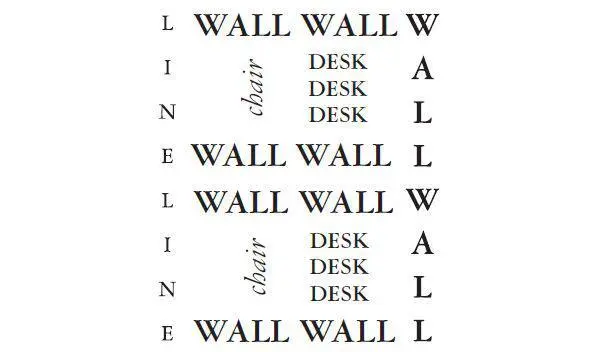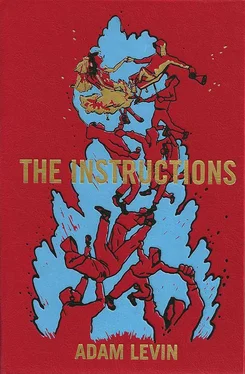I banged fists with Vincie, all kinds of relieved.
Sorry, I said.
“No problem, man. But what I was saying is,” he said, chinning air at Ronrico and the Janitor, who were making kiss-faces at him, “are we friends with these two knuckleheads now, or what?”
We’re all on the side of damage, I said.
“So we’re all friends or what though?” Vincie said.
“I told you we were friends now,” Ronrico said to Vincie. He said to me, “Vincie tried to say at recess that you didn’t mean we were friends and I told him he was wrong, just like how I told Mangey she was wrong about the bombs on the tables and the bleachers.”
“I said to Ronrico that he was a fuckface,” said Mangey, “because when you said we were on the side of damage, you didn’t mean that we were to the side of damage: you meant that damage is on one side, which is the side we are for , and then something else is on the other side, which is the side we’re against .”
“And then,” said Ronrico, “I told her that it was not me who was the fuckface since it was her mom who was the fuckface, because of how we already decided in Group that it was her mom who was the one who fucks like a fucker and that Gurion would not have said ‘We are all on the side of damage’ and left it that way if there was this whole other something else that we are against like Mangey is saying — I told Mangey it was maybe her that was the fuckface because of genetics and that you would have told us what the something else was, and I told her that it is true that I don’t know if we are on the right or the left side of damage, but I do know that it is one or the other. And that’s why I switched off the sides with the bombs. I did thirteen, starting with the WE on the left. So now there are seven WE DAMAGEs and six DAMAGE WEs.”
“Who’s right?” Mangey said.
Botha said, “In your seats.”
Those huddling around me pretended not to hear him.
I spoke fast. I said, We are all against the arrangement, always. I said, Sometimes we are on the left side of damage and other times on the right. Often we are on both sides, so both of you are correct.
“So I don’t have to fix the bombs?” Ronrico said.
I said, The bombs are good.
“Thank you,” Ronrico said. “Tomorrow I’ll scrape a huge WE DAMAGE WE into the four-square court with a rock. I would’ve done a four-square one today, but we had indoor recess, so I did the bleachers with a Darker instead — Oh we forgot!”
“Hey!” said Botha.
“Hey back at you!” said Vincie Portite, hand over eye. “I didn’t hear a tone yet!”
“The scoreboard,” Ronrico said.
Mangey said, “It’s smashed.”
Vincie said, “He knows already. God! You don’t listen to Vincie.”
“Did you really know already?” said the Janitor.
The beginning-of-class tone sounded and Botha scattered the huddlers to their carrels by shouting, “Mind the loin there!” What he meant was my tape-line.

Forty carrels were bolted to the walls of the Cage; sixteen to the east wall, and twelve to each the north and south. Stuck to the floor behind every student’s chair was a line of masking tape the width of his carrel. The rule was that you were supposed to keep the back legs of your chair in front of your line at all times. As long as your back chair-legs were in front of your line, your head would be between the walls of your carrel, which rose five feet higher than the surface of your desk and extended two feet beyond the desk’s edge. Because only the thinnest, most flaccid carpet covered the Cage’s concrete floor, and because all the feet of the chair-legs were metal, the noise of the feet rubbing the floor when you’d scoot your chair was a squeaky kind of groan that was wholly distinct from other Cage sounds, so breaking the Tape Rule was a risky move, since Botha — at his desk between the bathroom doors, in the middle of the west wall, facing east — or a teacher at the cluster in the center of the room, was likely to look in your groan’s direction. If you were over your tape-line, you’d get step 1. Step 1 was a warning. Three warnings in the same half-day = step 4: detention.
While following the Tape Rule, the only direction you could look that wasn’t walled off and didn’t end in floor or ceiling was behind you = you weren’t able look at anyone else without conspicuously revolving your head. And so there was also the rule of Face Forward, which was exactly what it sounds like. The rules of Quiet At All Times and Always Be Sitting — those were exactly what they sound like, too — combined with those aforementioned to make it near-impossible for students to initiate communication with other students without getting noticed, then stepped, by the robots.
On top of the rules, the stain-colored carrel walls were insulated thickly so that whispers below the robots’ audial threshold couldn’t break through them, and if you wanted to send a written message to someone, not only did you first have to ball the paper (folded notes’ trajectories just weren’t reliable), which got too noisy if you didn’t crumple slowly, but you basically had to be sharing a wall with the intended recipient, for it was near-impossible to arc even a balled note much greater a distance than the next carrel over with any kind of accuracy, which meant that if Benji Nakamook, say, was more than one carrel away from you, a note you wrote him, in order to get to him, would have to be tossed to every student between you, and since each between-student would need to unball it to see if it was intended for him or another, and because no student could see what any other was doing inside of his carrel anyway, every between-student could and would read the note without any fear of getting beaten up, so even if every kid between the two of you was willing to risk steps for tossing your note, and even if the note did eventually get to Nakamook without being detected by Botha or the teachers (the likelihood of which decreased with each potentially noisy de- and re-crumpling), you wouldn’t have written anything important in the note, and thus probably wouldn’t have bothered writing to begin with.
And for those of you scholars who, at this point, wish to accuse me of blithe exaggeration or of lying for effect; for those of you assuming I’m engaging with metaphor or trucking with expressionism, thinking to yourselves, “This place about which Rabbi Gurion tells us seemed so overbearingly stifling and hellish that it felt like he wasn’t ever allowed to speak to his friends, and at times it even felt like he wasn’t allowed to look at them; it was as if they had to stare at flat, unadorned surfaces six hours a day in total silence, and as though to do otherwise would garner them punishment”; for all of you scholars who’d like to insist that a classroom like the Cage, given all the violent uprisings its very existence would daily incite, couldn’t possibly abide for any longer than a week: believe me, I understand your objections. I was prepared no better by Schechter and Northside to experience the Cage’s smothering reality than you’ve been prepared by your Israelite schools to accept that smothering reality’s description.
As for why the Cage wasn’t plagued by daily (or weekly, or at least semi-annual) savage insurrections, the short answer’s this: Apart from me — the new kid still studying the others in the Cage to learn how it worked and how it got worked — its population was not comprised of scholars who’d spent their lives studying Torah and Talmud, but rather of kids for whom junior high had always = Aptakisic, if not the Cage itself.
Читать дальше













